How To Open Kettle Can Tarragon Pickles And Vegetables
Views: 160
Dill pickles have always held the title as the top choice for pickled cucumbers. While they’re undoubtedly a classic, there’s a world of creative pickling recipe flavors just waiting to be explored. When we say “creative,” we’re not talking about the run-of-the-mill bread and butter pickles recipe. If that piques your interest, then this tarragon pickles and tarragon pickled vegetables recipe is tailor-made for you. Furthermore, if you are looking for recipes specifically designed for open kettle canning, you’ve come to the right place. This step-by-step open kettle canning recipe will get you canning the old-fashioned way in no time!
Disclaimer and Caution
Without reservation, we state that the open kettle canning method is not an approved USDA canning method to preserve food. The information shared here is for general awareness and personal use only. Equally important, we acknowledge that the provided information may contain inaccuracies or errors, and we explicitly disclaim liability for any such inaccuracies or errors to the maximum extent permitted by law.

Vegetables to use
When we think of “pickles,” cucumbers usually come to mind. But here’s the thing: you can pickle cucumbers with other veggies in the same jar. Mixing them creates an interesting combination of flavors and textures. If you’re curious about pickled vegetables medley, you can use this recipe “as is”. However, if you just want a creative pickles recipe, you can skip the other veggies and still get a tasty tarragon pickles you crave.
A quick note about cucumbers used in this pickling recipe. Not all cucumbers are good for pickling. Those long English cucumbers or cucumbers sold as slicing cucumbers won’t give you the right crunch when pickled. If you like pickles with a satisfying crunch, you’ll need a specific type of cucumber. You can usually find them labeled as “dill cucumbers” or “bread and butter cucumbers” at your local farmers’ markets.
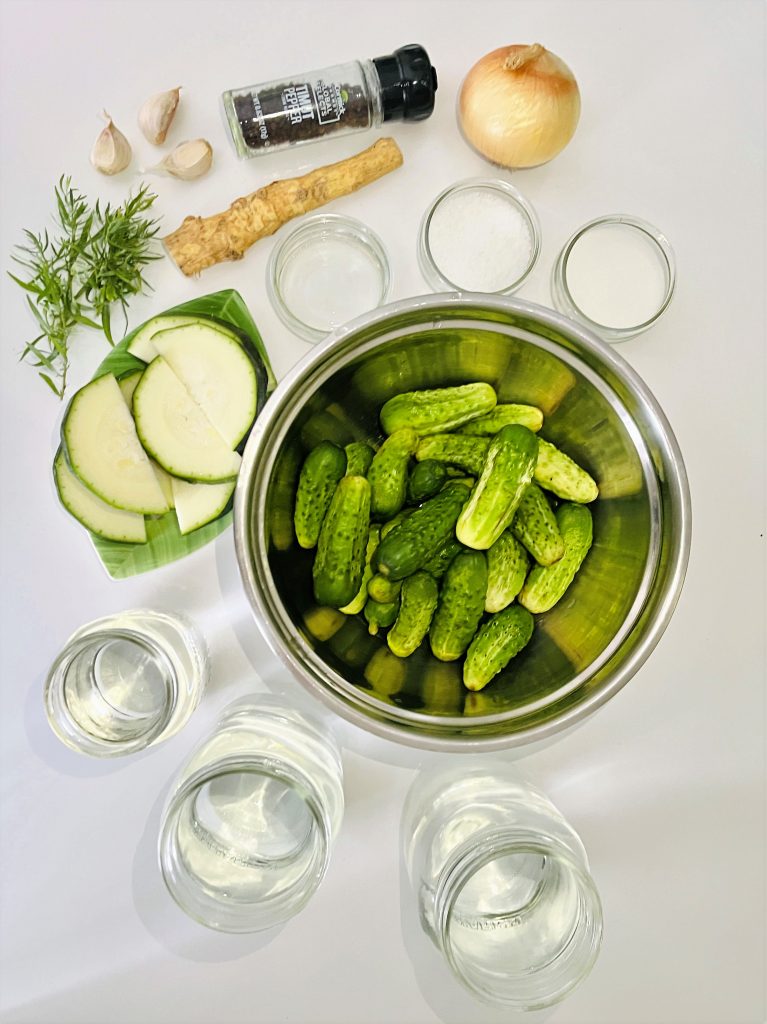
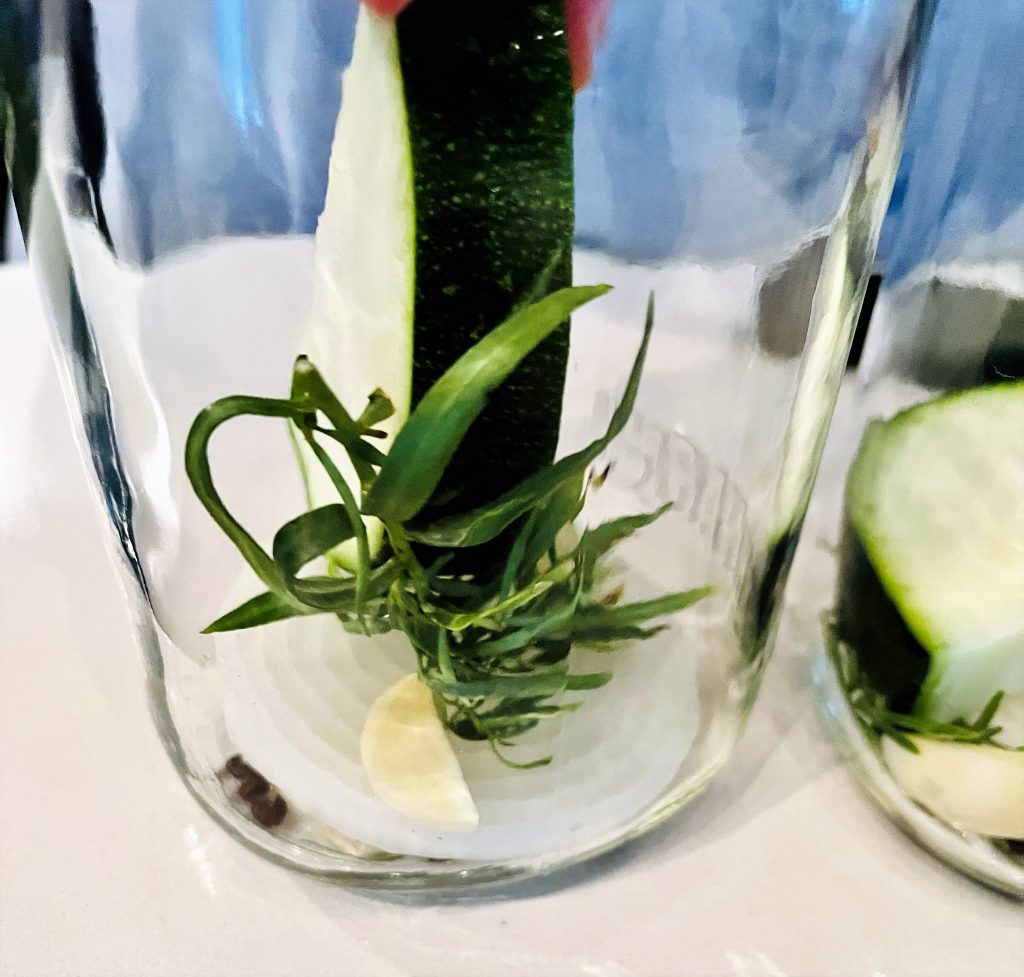
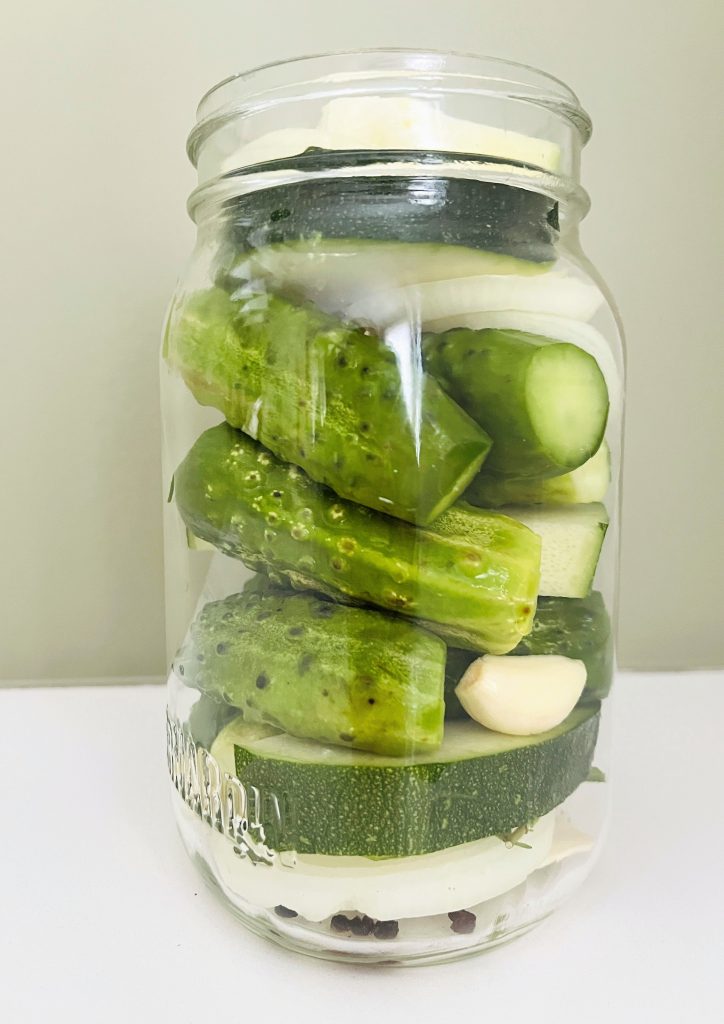
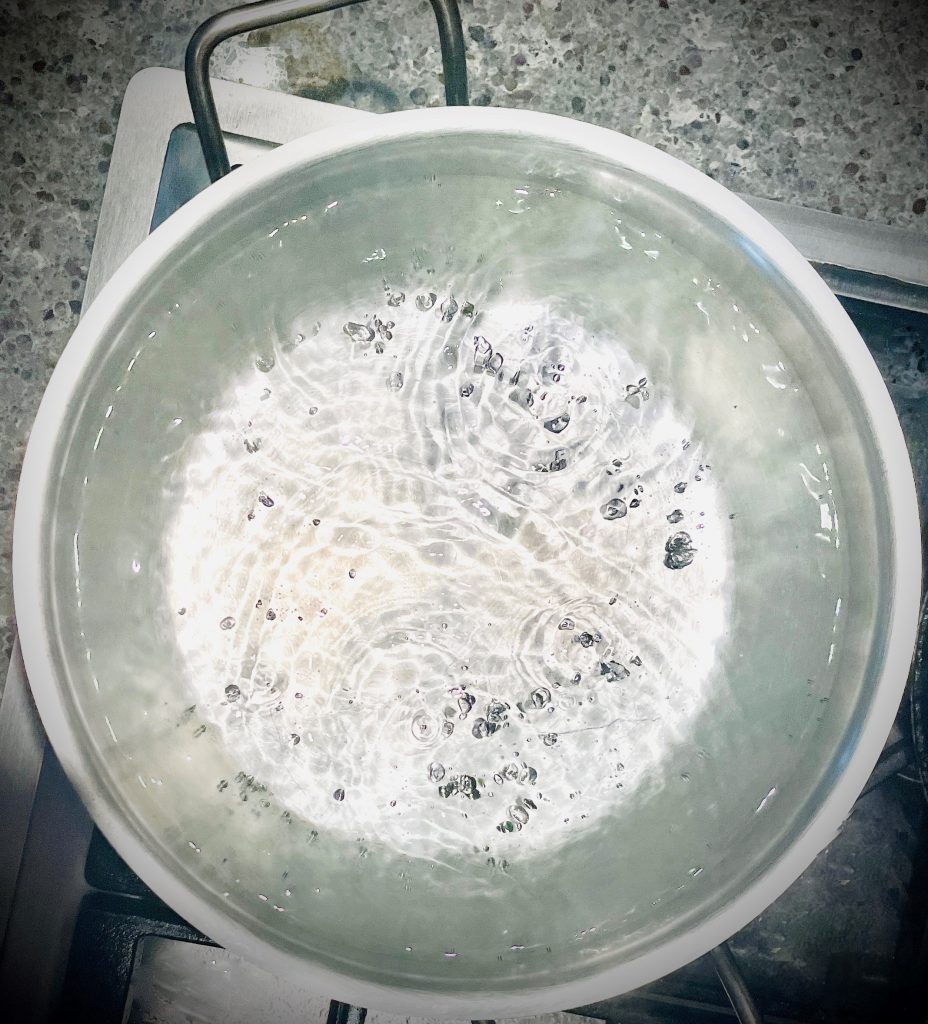
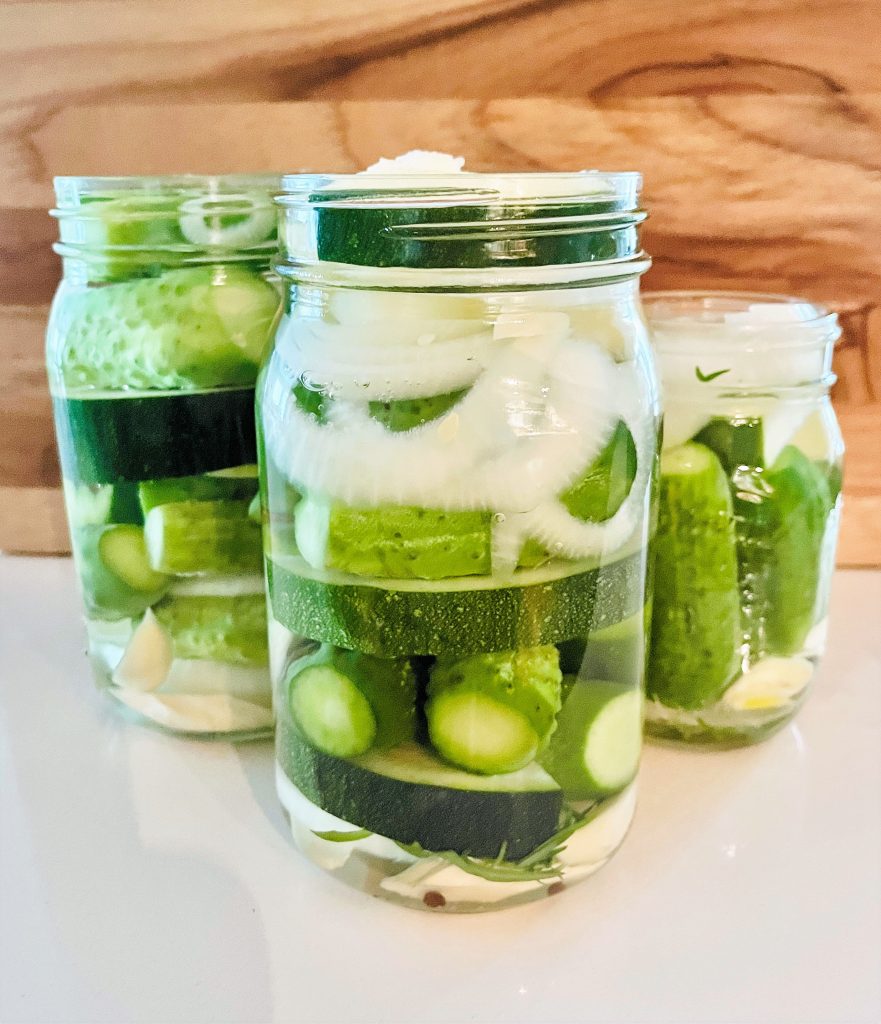
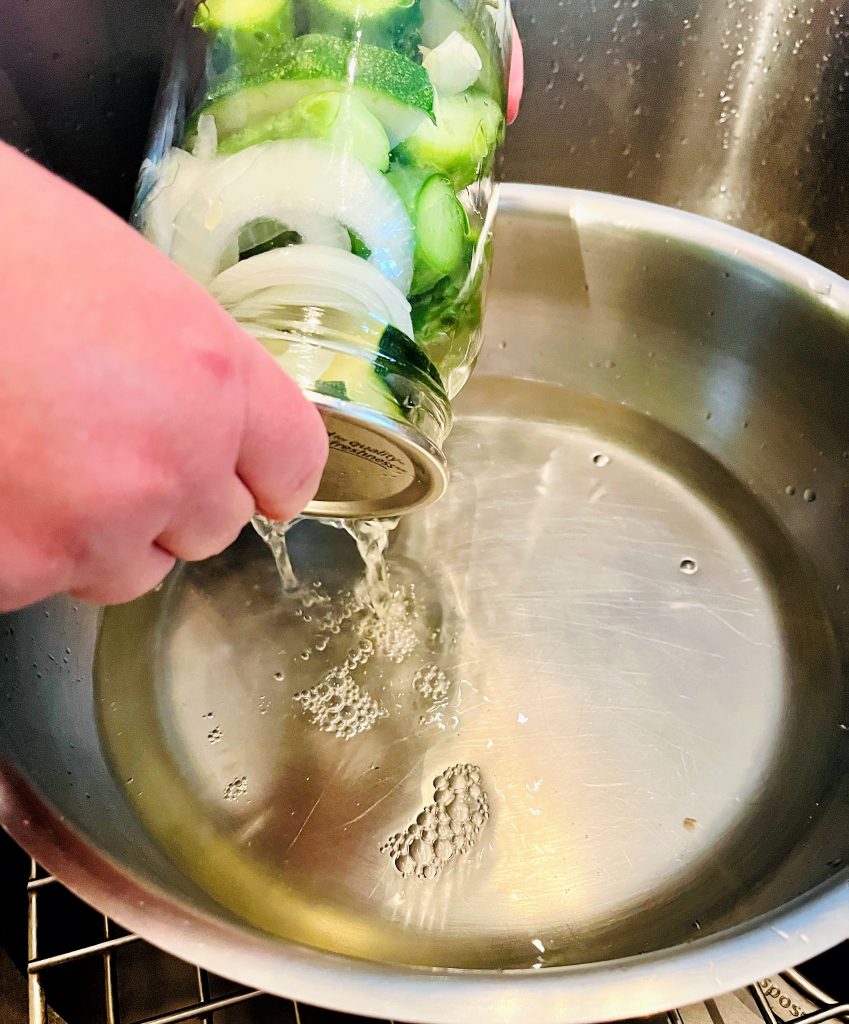
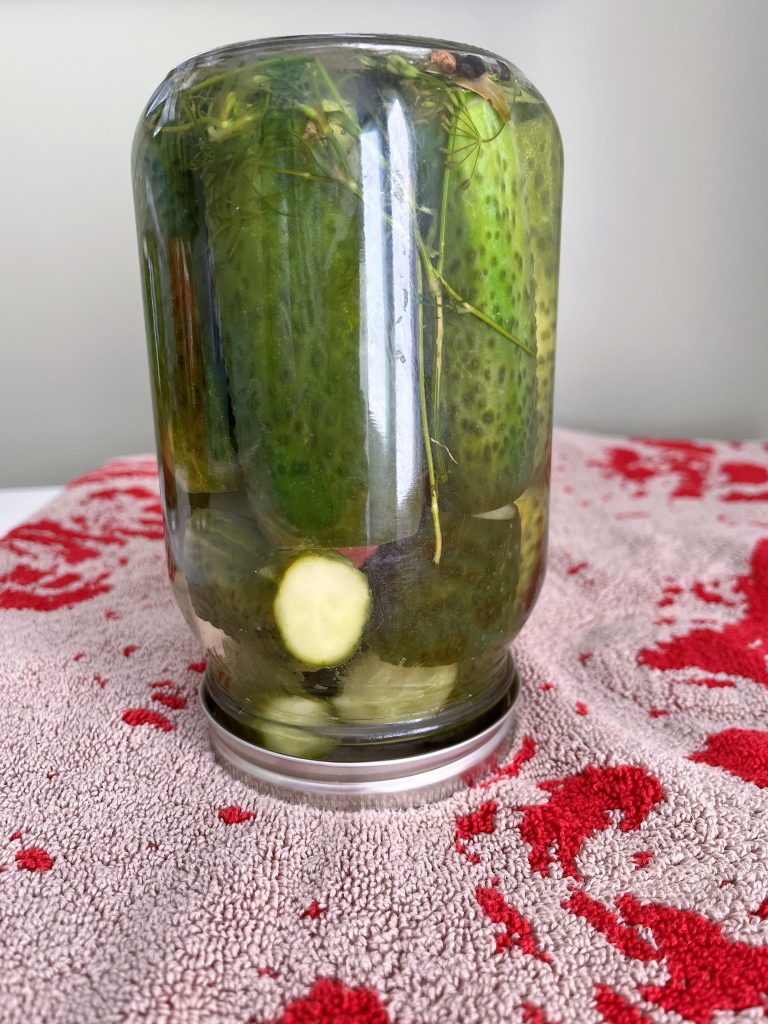
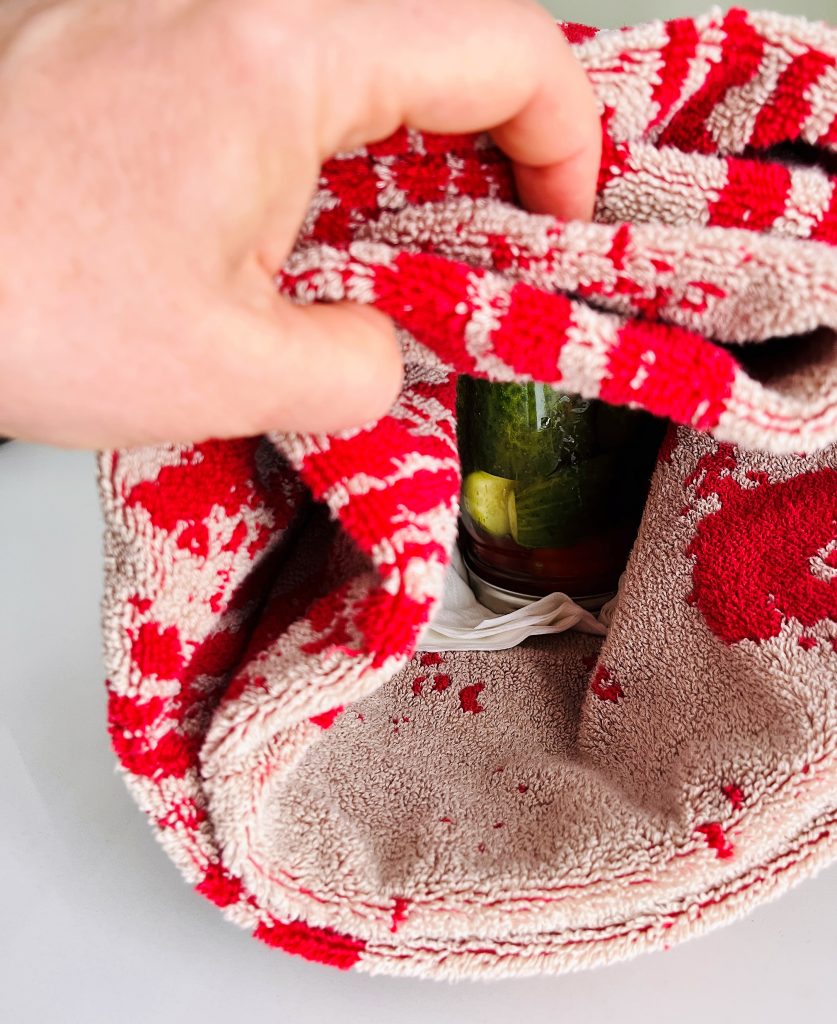
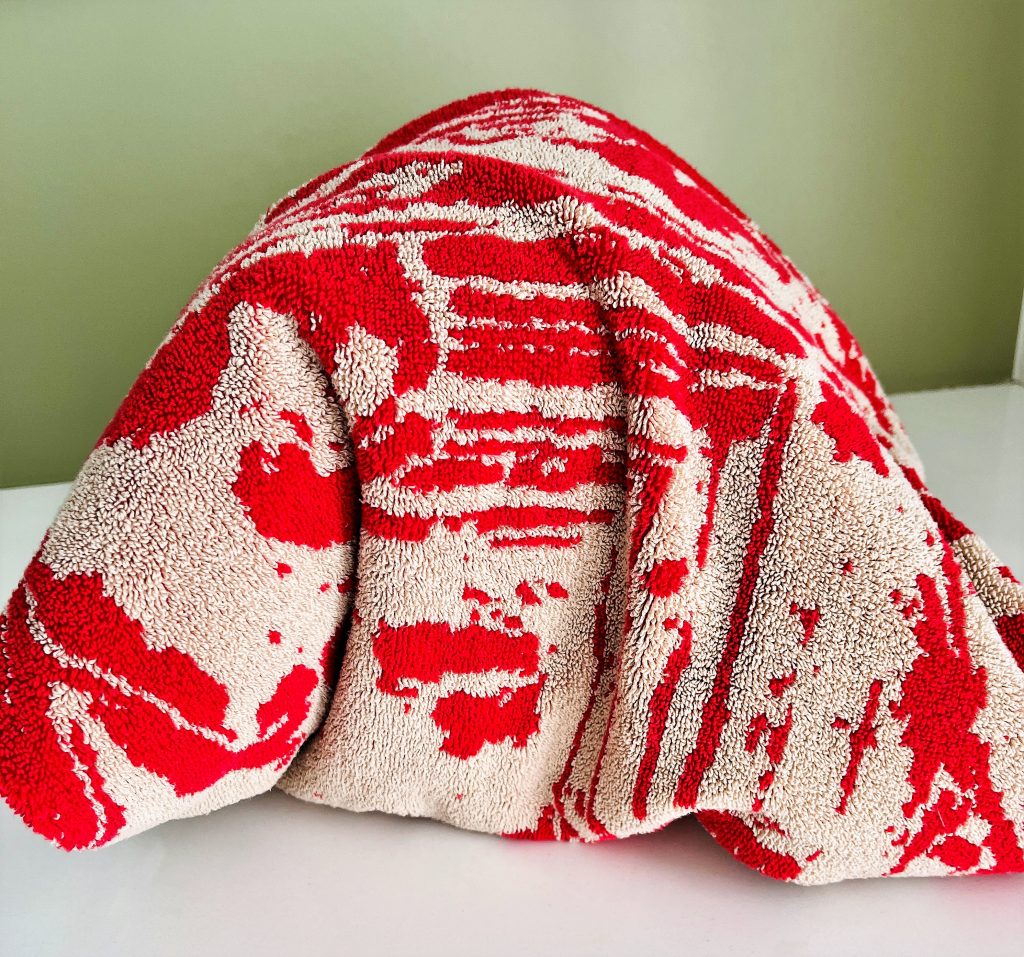
Pickled Vegetables With Tarragon – Recipe for Open Kettle Canning Aficionados
Equipment
- large pot
- potholders, oven mitts, trivets for hot dishes
- spoon
Ingredients
- 2 pounds Pickling Cucumbers (approximately 1 kg)
- 1 lb Zucchini, marrow, pattypan or summer squash (approximately 0.5 kg)
- 4.5 tbsp. salt
- 3 tbsp. sugar
- 4 tbsp. 7% pickling vinegar
- 5 small or 3 large cloves of Garlic
- 1 large yellow onion
- 3 tarragon sprigs
- 10 whole Timut pepper or whole black peppercorns
- 1 Horseradish root 8 slices, about ½ -inch each
- 9 cups water (approximately 2.5 L)
Instructions
Prepare the Vegetables:
- Begin by washing the cucumbers, then soak them in cold water for 2 to 5 hours. After draining, trim the ends of the cucumbers.
- Wash and slice the onions into 1-inch (2.5 cm) wide rounds.
- If you are using other vegetables, slice them into 1-inch wide rounds or cut them into halves or quarters as necessary to ensure they fit into the mouth of the jar.
- Slice the garlic into thin pieces.
- Slice horseradish root into pieces, about ½ -inch each.
Prepare the Jars:
- Ensure that the jars are cleaned with soapy water and sterilized following the method described in our post Learn how to prepare mason jars and lids for canning.
Pack the Jars:
- Once the jars are sterilized and cooled, start by placing garlic, pepper, tarragon, and horseradish root at the bottom of the jars. Divide the sliced garlic and horseradish, peppercorns, and tarragon equally between the jars, using less for smaller jars.
- Pack the cucumbers and other vegetables tightly into the jars, adding slices of yellow onion in between. The goal is to minimize empty space. If necessary, cut the cucumbers into halves or quarters.
Pour Hot Water Over Vegetables:
- In a pot large enough for the measured water, bring it to a rolling boil and let it boil for 5 minutes.
- Remove from heat and immediately pour the hot water into the jars containing the vegetables. It's best to do this while keeping the jars in a kitchen sink.
- Let the vegetables sit in hot water for 10 minutes. Do not discard any hot water you may have left in the pot.
- Carefully pour the water back into the pot, ensuring you don't scald yourself. Take care not to let the vegetables slip out of the jars while pouring the water back into the pot.
- Reheat the water in the pot until it boils again.
- Repeat the step #2: Gently pour the hot water into the jars once more, and let them sit for an additional 10 minutes.
Prepare the Pickling Brine:
- Pour the water from the jars back into the pot, and add the measured salt and sugar.
- Bring the mixture to a boil, continuing to boil until the sugar and salt are fully dissolved (approximately 5 minutes).
- Just before turning off the heat, add the pickling vinegar to finish creating your pickling marinade or brine.
Sterilize Jar Lids:
- As you're preparing the brine, bring a smaller pot of water to a boil to sterilize the lids as per below. Remember not to let the lids boil; turn off the heat just before placing them in the hot water.
Final Steps:
- Carefully pour the hot brine into the jars containing the vegetables.
- Swiftly cover the jars with the lids and firmly secure the lid bands. Ensure the lids are tightly sealed until you can no longer move the bands.
- Turn the jars upside down and tightly wrap them in warm towels (use 2-3 beach towels for three large jars).
- Leave the jars upside down, snugly wrapped in towels, for 2 days or until they're completely cool to the touch.
- Congratulations, your jars are now ready for your pantry!
Frequently asked questions
How soon can you eat pickles
When it comes to pickles, patience pays off. For best results, wait at least a week before cracking open your freshly made pickles. For the best taste, give them a full month.
What jars should you use for this pickles
We use 1-liter (32 oz.) Mason jars with a wide mouth. They’re super handy for pickling cucumbers or pretty much anything else. And don’t worry if your vegetables don’t quite fill up the whole 1-liter jar – you can use a half-liter jar (16 oz.) to pickle the remaining vegetables.
How is our recipe different from others?
This recipe is a fusion of tradition and innovation. The “new” aspect is the exciting flavor profile we’ve developed for these pickles. The “old” part hails from our Ukrainian heritage, reflecting a time when pressure canners were nonexistent, and water baths were excessive. These pickled vegetables are meticulously crafted using time-honored techniques passed down through generations, resulting in an authentic, mouthwatering crunch that modern methods just can’t replicate.
Plus, they can be stored on your shelf for three years if not more.
So, there you have it – pickles that blend the tried-and-true canning methods of the past with the bold flavors of the 21st century, delivering an irresistibly winning combination.
Can I make these pickles in a water bath canner?
This recipe was specifically designed to work with open kettle canning method. We have adjusted this recipe to work with water bath canning and will publish it shortly.
Can pickled cucumbers prepared this way go bad?
Yes, pickled cucumbers can go bad. While the pickling process helps preserve cucumbers, factors such as improper sealing, contamination, or extended storage can lead to spoilage. Signs of spoilage include a change in color, off-putting odor, or the presence of mold. If you notice any of these signs, it’s best to discard the pickles to avoid the risk of consuming spoiled food. Proper storage and adherence to recommended pickling procedures can help prolong the shelf life of pickled cucumbers.
Isn’t open kettle canning unsafe?
Glad you asked! For all those interested to learn about open kettle canning, including questions of open kettle canning safety, we recommend this article to get your started.
Using Pickled Vegetables: Versatility at Its Best
These pickled vegetables are a flavor-packed wonders waiting to be explored. Here are cool ways to enjoy them:
- With Grilled Meats: Serve them as a side to grilled meats for a delicious combo of flavors.
- With Burgers: Make your burgers epic! Jazz them by adding a slice of a marrow or a pickles on top of a grilled burger patty.
- Must-Have for Sauces: These pickles are a secret weapon for sauces like Sauce Gribiche, Remoulade, and homemade Tartar Sauce.
Whether you’re grilling, tossing salads, or saucing things up, these pickled cucumbers are your go-to for adding that special something to your food.
You may also like:
-
Sweet Tart Yellow Mirabelle Plum Jam Recipe: French Confiture Style
This sweet tart Mirabelle plum jam proves you don’t need a Parisian zip code or deep pockets to enjoy something classy and extraordinary. Got yellow plums in your backyard? One recipe, two simmers, and you’ve got a jar fit for a glass shelf in a French confectionery.
-
Boozy & Spiced Seedless Raspberry Jam for Grown-Ups
Our raspberry jam breaks out of the mold. Seedless, low sugar, spiked with port and pepper, this is the jam that went rogue. It’s like that guest at a polite garden party, that shows up wearing leather boots and carrying a bottle of booze. Bold, smooth and unforgettable. Make it! Go rogue!
-
Make-Ahead Christmas Jam Recipe (Cranberry-Strawberry Jam)
You could wait until December to make your Christmas Jam. You could. But let’s be honest: December is full of burnt cookies, delayed packages, and half-wrapped gifts. You’ll be frazzled. But if you make it now—when strawberries are sweet and plentiful, you’ll feel like a wizard in December A smug, cinnamon-scented wizard.
-
Authentic Ukrainian Cabbage Rolls (Holubtsi) Recipe & More
You may know Ukrainian cabbage rolls as comfort food, but did you know they’re the ultimate make-ahead freezer meal? Holubtsi start out delicious but turn next-level amazing after a night in the fridge or freezer. This guide will teach you to roll, cook, and most importantly reheat them like a pro. Spoiler: make extra!
-
Blood Orange Marmalade: Your New Favorite Citrus Jam Recipe
To all the citrus marmalade haters out there—we see you. And we promise: this blood orange marmalade is different. It’s bright, bold, and anything but boring. It even has a dash of booze! Give it a try this winter, and you just might find yourself joining the citrus marmalade fan club.
-
Soy Sauce Pickled Cherry Tomatoes: Try Bold, New Pickle Flavor
Yes, you can make soy sauce pickled cherry tomatoes! They are a bold twist on traditional pickles, delivering an unexpected burst of umami and sweetness. Forget ordinary vinegar-based brines—this recipe transforms your tomatoes into an unforgettable flavor bomb. Perfect for snacking or charcuterie boards, this unique pickle will wow your taste buds!
-
How To Pickle Cherry Tomatoes: Easy Recipe, Tips, And Troubleshooting
Cherry tomatoes are the candy of the vegetable world, but they don’t last forever—unless you pickle them! Try this easy, beginner-friendly recipe for the perfect homemade holiday gift. Pickled and canned cherry tomatoes make a great addition to your charcuterie board and add a pop of color, like little jewels, to your holiday table.
-
Fried And Pickled Sweet Banana Peppers: Recipe For Canning
Looking for a simple way to jazz up your charcuterie board? This fried and pickled sweet banana peppers recipe is your new go-to! These peppers are easy to can, so you’ll always have a jar ready to impress guests—or just treat yourself. Plus, these canned banana peppers make a great side for any meats!
-
How To Make Pickled Roasted Bell Pepper
Pickled roasted bell peppers are a pantry staple, and making them at home is easy and rewarding. With rising prices and growing interest in food quality, now is the perfect time to roast and pickle your own. It’s a simple way to save money, control ingredients, and enjoy healthier peppers in your meals!
-
Your Cheese Board’s New Best Friend: Spicy Pear Jelly
Introducing Spicy Pear Jelly. It’s sweet, spicy, and it’s the perfect match for a variety of cheeses, from mild to bold. And yes, it’s as delicious as it sounds! Unquestionably, a little jar of this golden goodness deserves a spot on your next charcuterie board spread. Here’s a quick recipe to get you started!
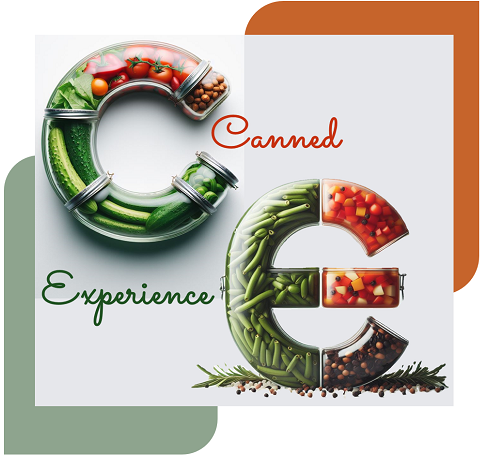

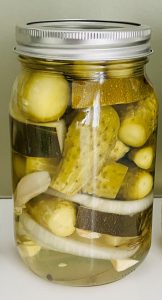
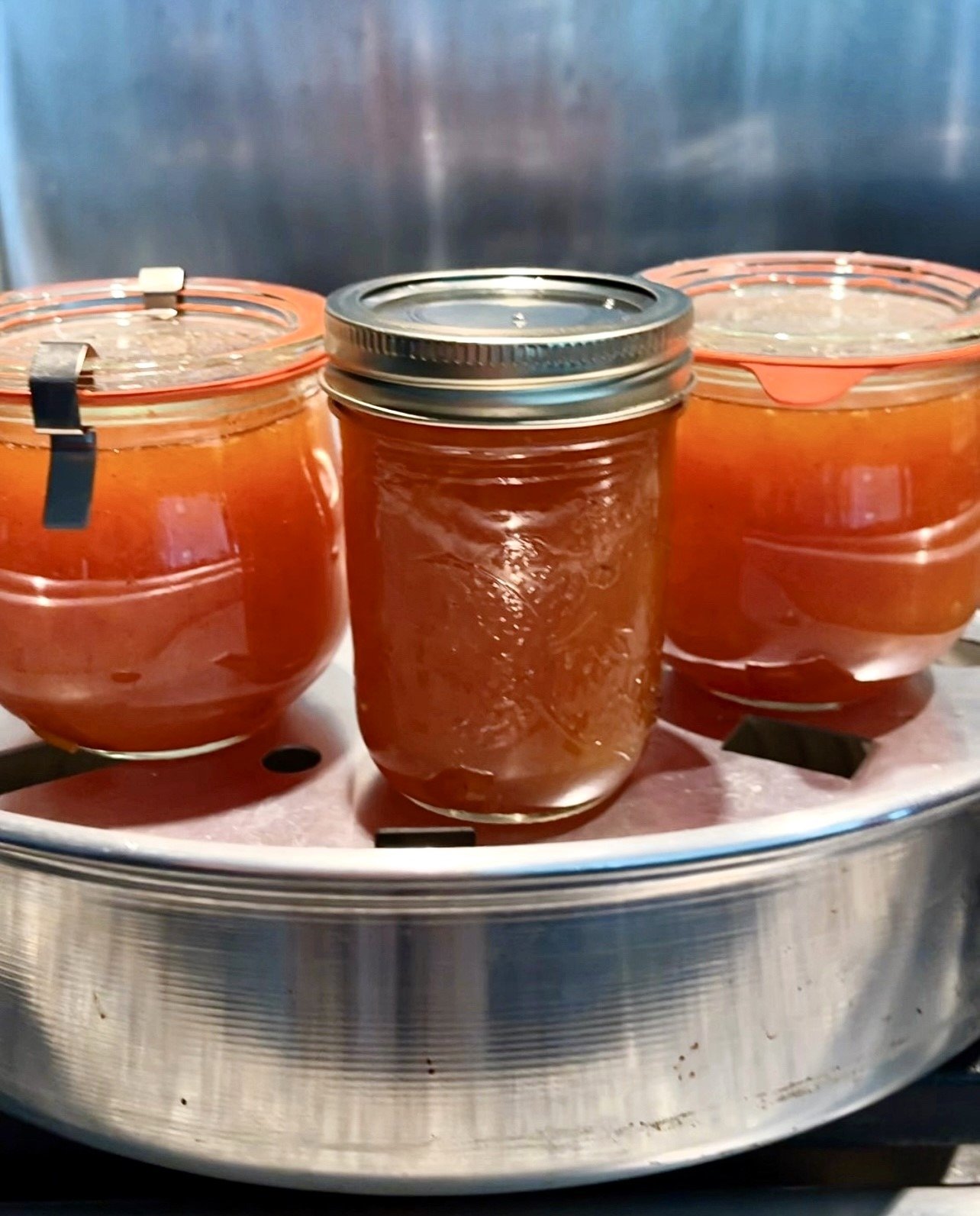
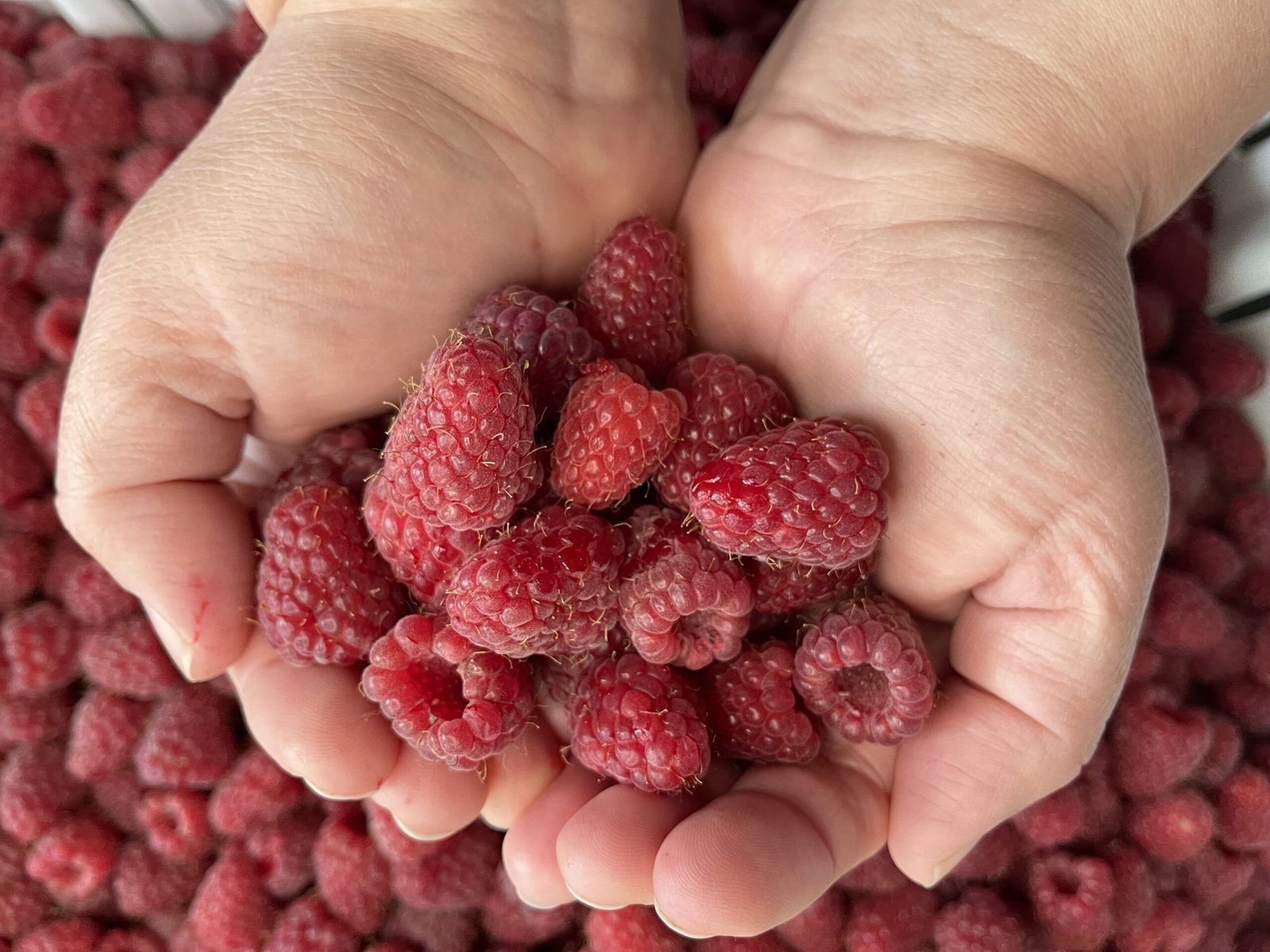


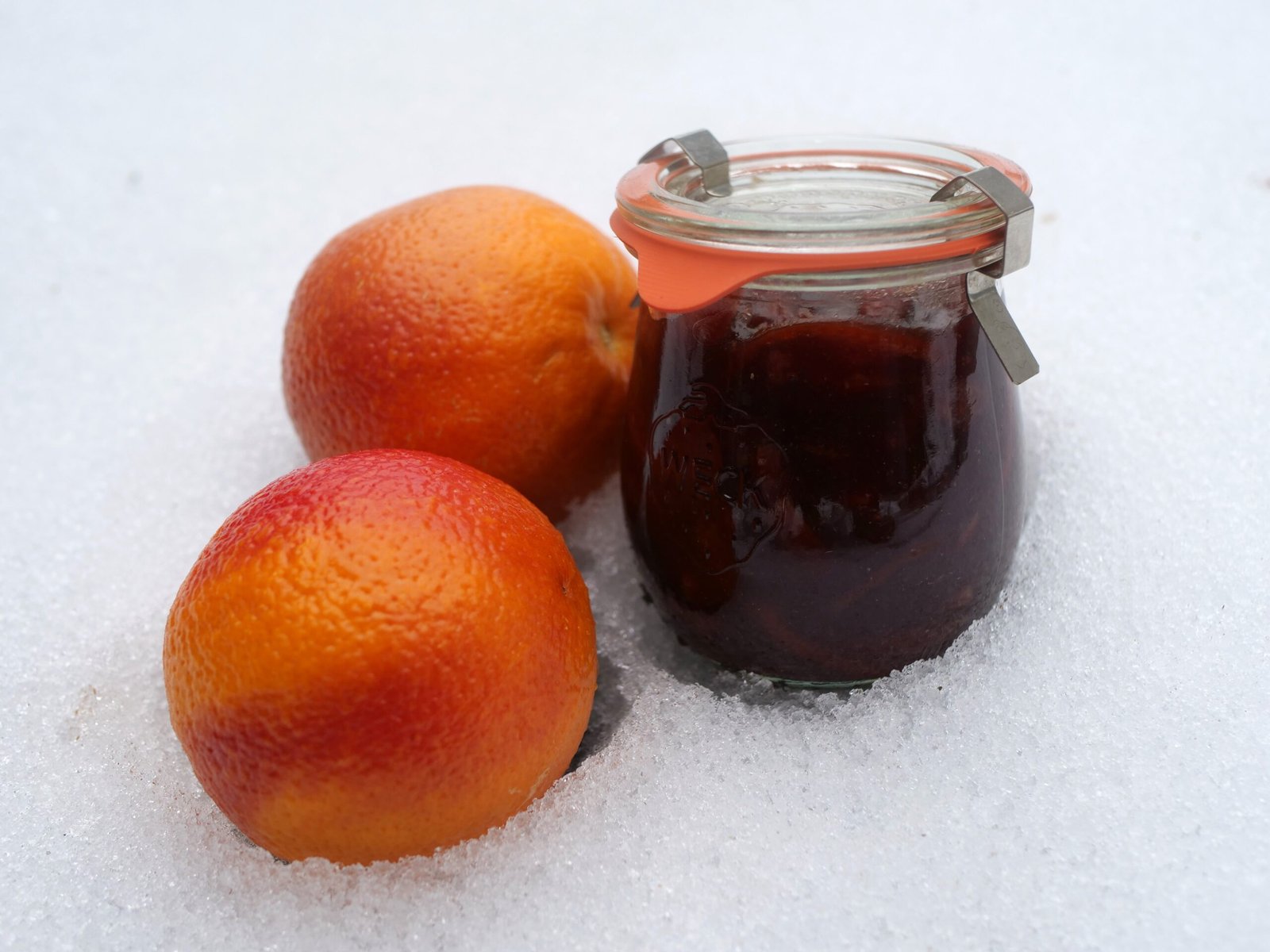
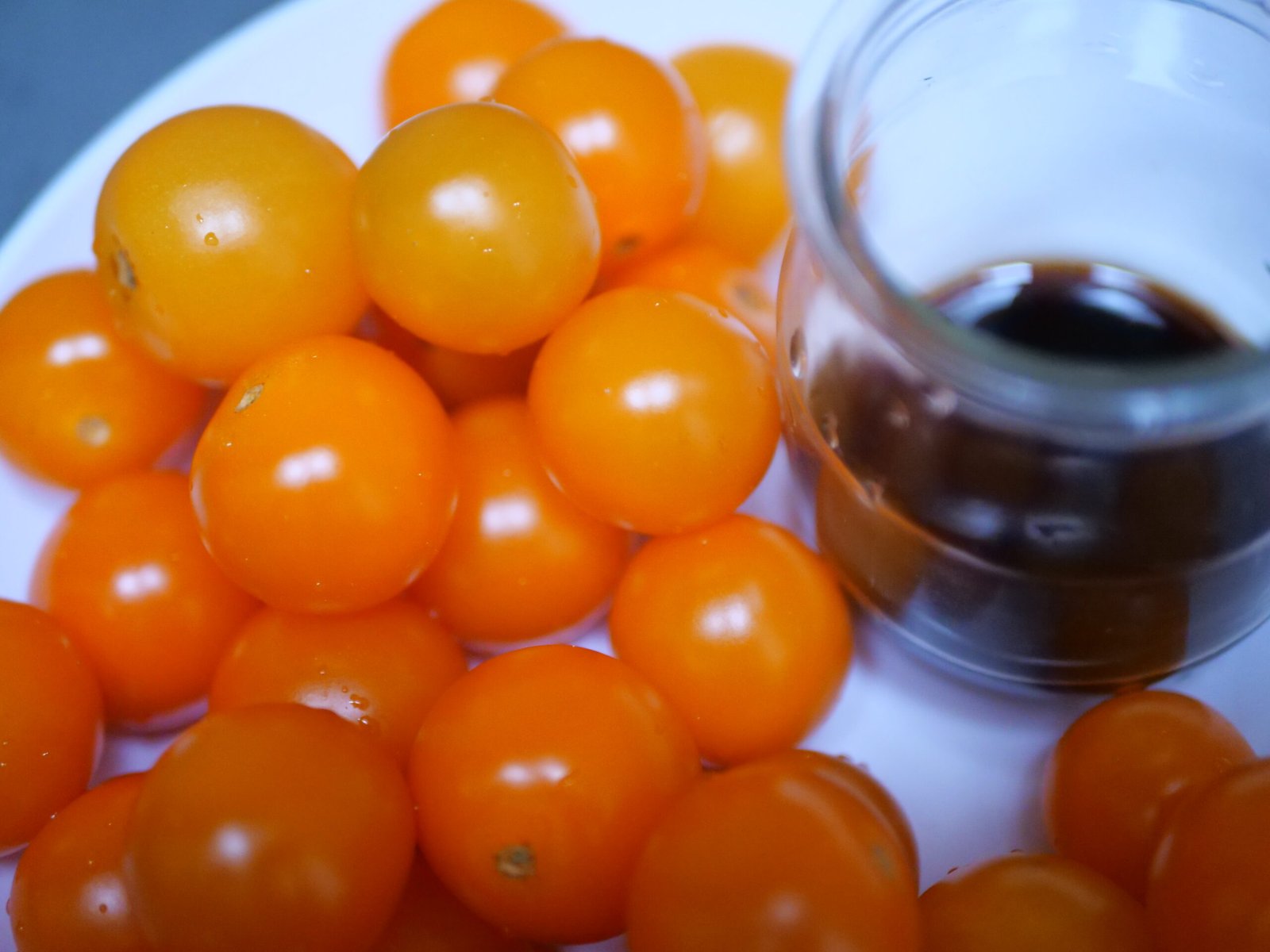
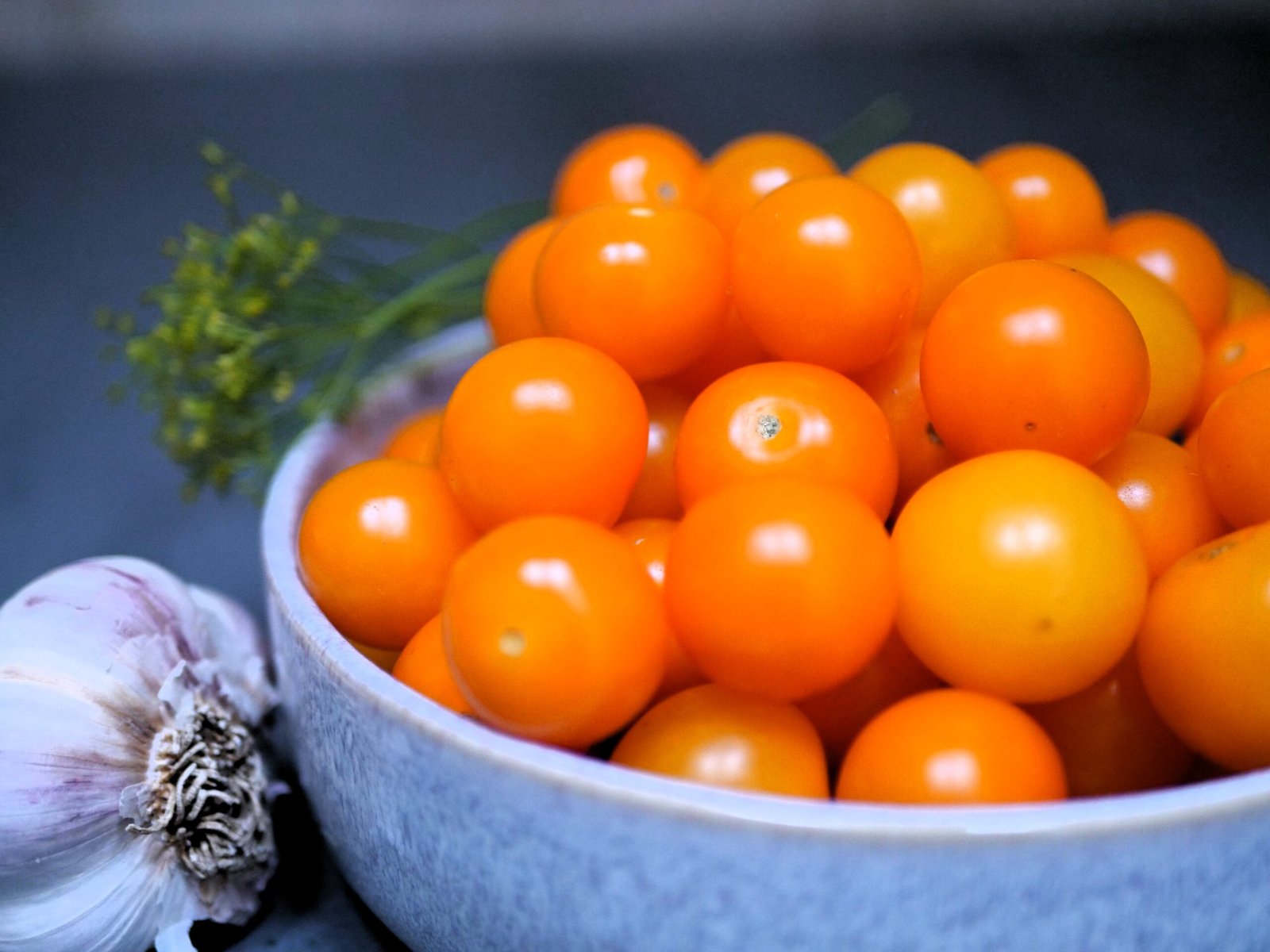


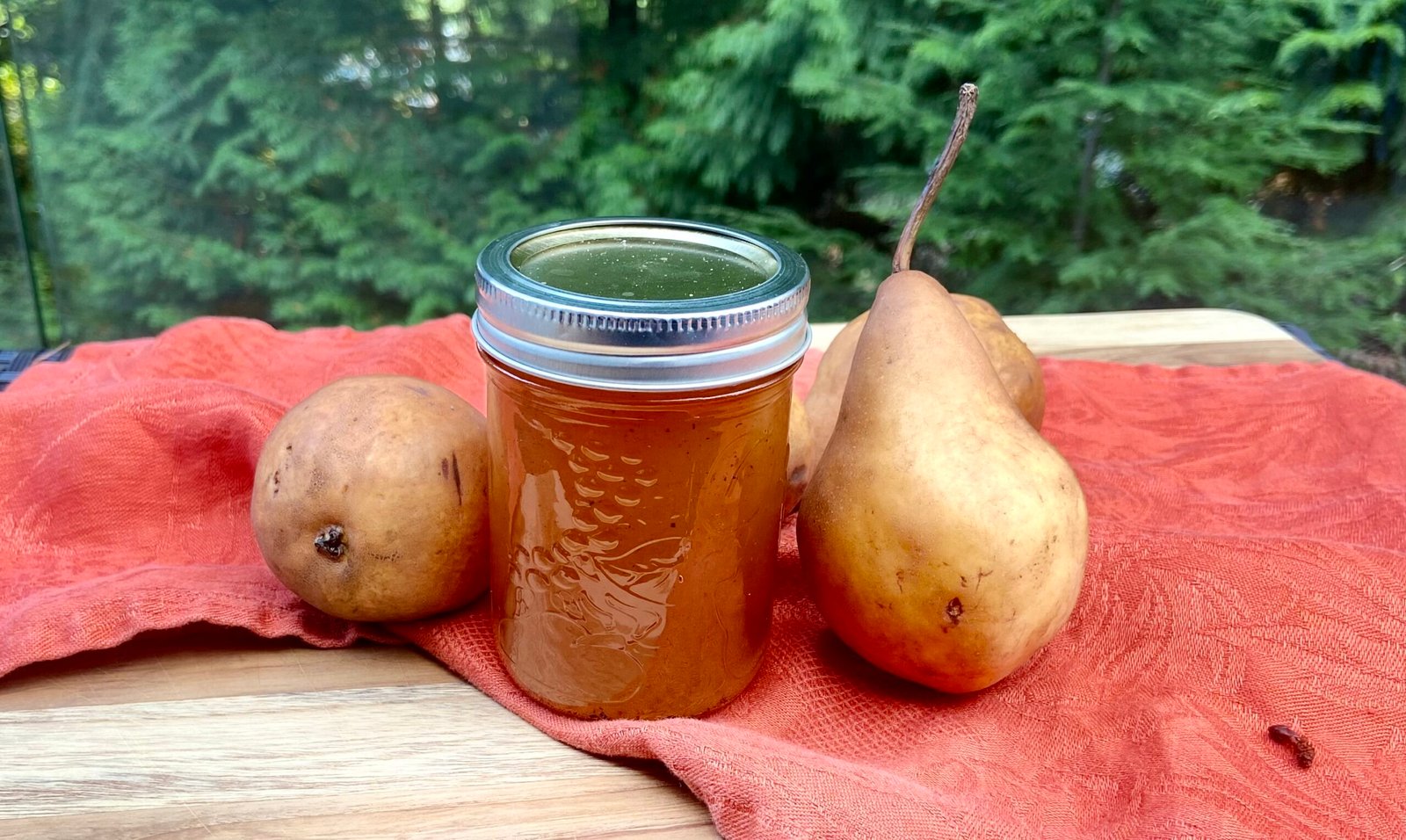


Leave a Reply